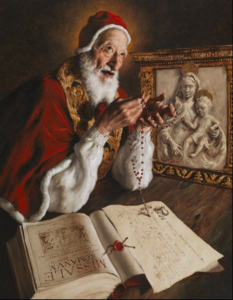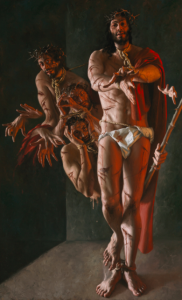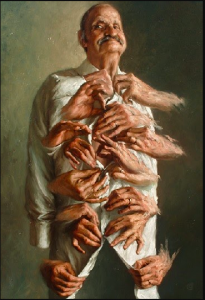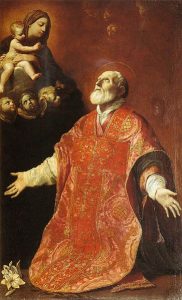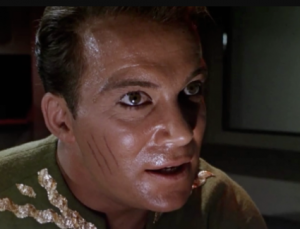What makes sacred art sacred?
By Hilary White
(Hint: it’s not just the subject matter).
Had an interesting exchange on FB today with a good friend back in Canada. He’s looking for a painter to commission some paintings for a church he’s in charge of.
He posted one pic of a painting of Pius X and for a while I kept looking at it wondering why I didn’t like it. And then I started wondering about it in the context of the weird mania among bishops for commissioning soul-crushing anti-religious art and architecture, like the planned reconstruction of the Basilica of St. Benedict the bishop of Norcia is threatening.
He also posted this one of Pope Pius V.
They’re by Giovanni Gasparro, a youngish painter in Rome.
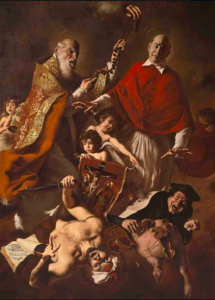 His painting of St. Charles Borromeo and St. Pius V defending Catholicism against Islam and the Protestant Heresy was featured recently on Rorate Caeli.
His painting of St. Charles Borromeo and St. Pius V defending Catholicism against Islam and the Protestant Heresy was featured recently on Rorate Caeli.
My friend, of course, was impressed that anyone would in our times be creating serious sacred art, particularly with such “controversial” and traditionalist themes. Note in the painting of Pius V the prominence of the Missale Romanum, the text of the “Tridentine” Mass that this pope promulgated after the Council of Trent, and the second document, against the sin of Sodom. It’s certainly clear that this artist shares some of the traditional Catholics’ ideas and religious sensibilities.
I had come across this painter’s stuff before, around about, and of course was struck first with the excellent quality of draughtsmanship; this is someone who has certainly learned classical realist drawing and has a very firm grasp of anatomy, extremely rare skills among artists trained in mainstream (non-Atelier) schools. But as usual, though it is clear there are strong Catholic themes in nearly all his work, this is someone who still approaches sacred subjects with a distinctly modernist mindset.
As I kept looking at it, the sense of something being seriously “off” kept growing. Then I realised that this is not actually sacred art in the traditional sense.
A look at the artist’s other work rather confirms this.
“Unease” immediately grows to being genuinely creeped-out. This is surrealist, not sacred art.
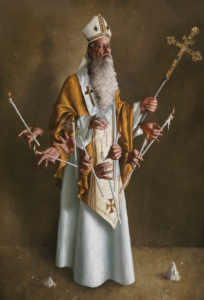
He seems to be really big into this creepy thing with the multiple floating hands. This is what I would call “schtick” and it is common among highly trained younger artists who think that having a schtick will get them brand-recognition.
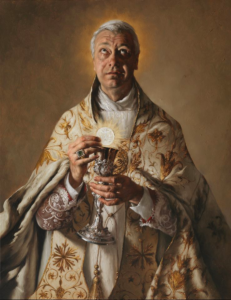
This is the painting my friend posted, a portrait of Pope Pius X, of whom my friend is a huge fan.
In fact, despite it’s deliberate hyperrealism, this isn’t even a good portrait of Pius X.
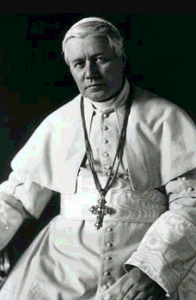 Giuseppe Sarto – even in death – had a very “beatific” face, handsome and always with a very assured and calm expression. I can’t imagine him ever making a face like the one in the painting. In fact, it looks more like what you’d get if you cloned Pius X and added a few drops of Nigel Farage.
Giuseppe Sarto – even in death – had a very “beatific” face, handsome and always with a very assured and calm expression. I can’t imagine him ever making a face like the one in the painting. In fact, it looks more like what you’d get if you cloned Pius X and added a few drops of Nigel Farage.
But mainly, there are other reasons that this is not actually sacred art. It looks like sacred art because it is all the same kind of subject matter, and it is done in a deliberately Baroque-esqe style. But it’s not sacred art because it’s not devotional art; its Baroqueyness is in fact a parody of the Baroque – irony and mockery being the modernist’s mother tongue.
To see what I mean, let’s look at a counter example of a similar style. This painting – of St. Philip Neri by the great Roman Baroque master, Guido Reni – is authentically devotional. We see the lumps and bumps of old age, but they’re not reproduced in the frantic hyperrealist style just to depict as many lumps and bumps as possible. This is an idealized old age, as if one were meeting an old person in heaven for whom age has been cleansed of its pains and divinised to leave only the wisdom.
Compare this with the modern depiction of Pius X above, who is all lumps and bumps, and whose facial expression is one of apprehension, not adoration.
But more importantly, in this modern painting the light is coming from a very strange angle, from below left. Look where the light is coming from in the painting of Philip. It’s the typical Baroque light direction: above and from the left, meaning from the group of heavenly people he is seeing in his ecstasy. It indicates that Philip is looking up at the Source of light – symbolically the “Light of the world” in heaven.
But the painting of Pius X is underlit, a type of lighting that we associate with evil. If you see horror movies, the light is often placed this way on a face to give it a frightening, even demonic effect. It’s what springs to mind: where does a light come from if it’s up from below? Still, is hell’s light this white, electric glare?
Evil Kirk, from the epsisode “Enemy Within,” underlit to make him look scary. (Because its not a Hilary-post without a Trek reference.)
This effect, illuminating the facial structure from an odd and unnatural angle – light doesn’t usually come from the ground up, still less heavenly light – the underside of the brow ridge lit up, giving the eye sockets a sickly, sunken appearance, etc… None of that is going to be found in genuine devotional sacred art. Also, in the painting, Pius X isn’t looking toward the source of the light as though in adoration of God, but up and to the right, away from the light source, and the expression being … what? I said apprehension above, but is it more like exasperation? I don’t know, but it’s certain that it’s not adoration or ecstasy. Moreover, at the Elevation at Mass, would a saint be looking away from the Eucharist? (He’s also not correctly vested for celebrating Mass, and is holding the Chalice incorrectly, in a careless manner as though he is about to drop it.)
The “light” from the Eucharist isn’t actually light. It illuminates nothing, there is no reflection of it on the face or hands or vestments. The halo is equally dead as a light source, since it falls on nothing. The only light on the figure is from this lower left white source – like a stage light. The non-light from the Eucharist could be a signal; is he saying, “This is NOT the light of the world”?
One gets the impression that the message of the painting is that Eucharistic theology is deception; there is no light from the Host, the celebrant does not believe; his face says “this is all theatre & flummery”
In fact, the more you look at it, the more the feeling grows that this is actually a parody of sacred art. As a friend of mine commented, “His face in no way looks beatific.” There’s something in this hyperrealism, all the lumpiness and the harsh white lighting, that doesn’t say heavenly to me, but psychotic. They seem like subtle corruptions of reality.
Knowing nothing about him other than what he paints, I have no idea what this artist intends – and that right there should tell you that he’s NOT doing sacred art – but it seems that in general hyperrealism simply isn’t going to work for devotional art. It’s always going to come across as strange and parodic, because the purpose of devotional painting is not to depict ordinary earthly reality – with all its “warts” – but a supernaturalised, idealised and perfected reality, a redeemed reality, that can only be occasionally glimpsed in this life by seeing the saints.
Sacred art is devotional art. If it isn’t devotional, it’s a parody of the sacred.
~
